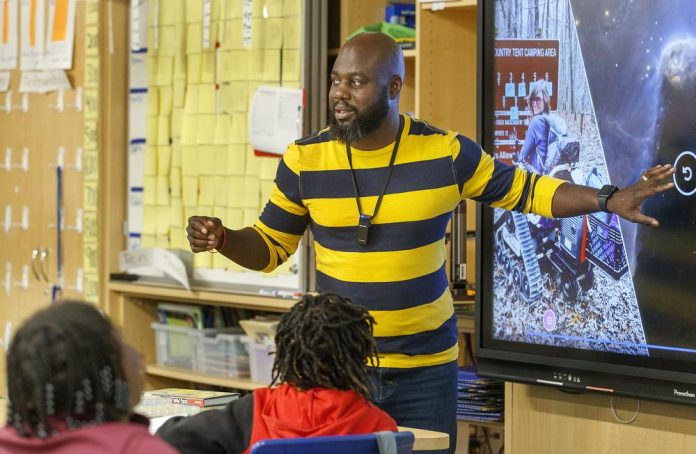
By DEVNA BOSE, The Post and Courier
CHARLESTON, S.C. (AP) — After a student in his classroom had yet another outburst, Tyler Wright couldn’t bear to see him get written up again. Wright, then a student teacher at a Charleston elementary school, led the child out to the hallway for a chat.
Within minutes, the student started crying.
“He was telling me that he really doesn’t get to see his dad and stuff like that,” Wright said. “That his dad was supposed to come see him but never did. At the end of the day, that was the root cause for the outbursts, because the child was angry.”
Wright told him that he grew up in a similar situation, but he still paid attention the best he could, despite what was going on at home. The conversation was all it took, Wright said, for the student to open up and improve his behavior.
Wright became a full-time teacher at Stono Park Elementary in January, thanks to a program in Charleston aimed at making the teaching profession more accessible to Black men, who are vastly underrepresented in classrooms in South Carolina and around the United States.
Just 7% of America’s public school teachers were Black during the 2017-18 school year although Black students make up 15% of the student population, according to the most recent available data from the National Center for Education Statistics.
Their absence in classrooms is deeply felt, especially in states like South Carolina, where almost a fifth of students are Black and Black males account for less than 3% of teachers.
Having teachers who reflect the identity of their students can foster connections between teachers and students — and help avoid the kind of misinterpretation of behavior that can contribute to disparities in discipline for Black students, experts say. Research shows that Black teachers can lead to improved academic performance and higher graduation rates for Black students.
At a time of teacher shortages in South Carolina and around the country, the presence of Black teachers also can make it more likely for Black students to pursue careers in education themselves.
“The issue starts fairly young,” said Eric Duncan, a member of the policy team at the Education Trust, a nonprofit advocacy organization. “They get negative impressions of school because they are traditionally overdisciplined or misidentified in terms of behavior challenges, when they may have some other issues or challenges that should be addressed in a more culturally proficient way.”
There are other barriers to the teaching for Black men. Many come from low-income families and face pressure to find higher-paying jobs, and there are license requirements that were deliberately created to prevent people of color from becoming teachers, Duncan said.
The program in Charleston, Men of CHS Teach, is a partnership between the University of South Carolina and the Charleston County School District. It places new teachers in elementary classrooms even if they haven’t participated in a student teacher program and creates an alternative pathway for them to get teaching licenses.
CCSD decided to focus on recruiting elementary teachers because it’s typically difficult to fill those positions with men, and research shows that if Black students have a teacher of color in elementary school, they’re less likely to drop out of high school and more likely to consider college. For Black boys of low-income backgrounds, those effects are even greater.
Program organizers hope to hire 20 male teachers of color within the next five years. Close to half of the district’s student population is non-white.
Wright was one of the program’s first inductees. He decided he wanted to teach after working as a student concerns specialist at one of the district’s high schools. A few years later, Wright is leading a classroom of his own.
The South Carolina districts that have seen the greatest increase in Black male teachers in recent years are Charleston, York 3, Richland 1 and Aiken, with a net total of almost 80 new hires from 2017 to 2021. However, they still have a small share of Black male teachers overall.
Statewide, the racial demographics of teachers barely changed between 2016 and 2021, according to an analysis of state teacher workforce data.
The program in Charleston was partially inspired by Call Me MiSTER, a Clemson University program that aims to recruit, train and certify men of color to become elementary school teachers in South Carolina.
Mark Joseph, the program’s director, said they’ve seen a decrease in applicants in recent years and have had to put more effort into recruitment. It’s a new era of teaching after the pandemic, Joseph said, and the program has had to adapt.
“We took a different approach in terms of talking about leadership, talking about college, talking about what it’s like being a part of a program that provides support, encouragement, brotherhood and teamwork,” he said.
One realization, he said, has been that teachers are ambassadors for the teaching profession.
After all, the teachers they’re looking to recruit aren’t coming out of thin air — they’re sitting in classrooms across South Carolina.
___
This story is part of Tackling Teacher Shortages, a collaboration between AL.com, The Associated Press, The Christian Science Monitor, The Dallas Morning News, The Fresno Bee in California, The Hechinger Report, The Seattle Times and The Post and Courier in Charleston, South Carolina, with support from the Solutions Journalism Network.
___
The Associated Press education team receives support from the Carnegie Corporation of New York. The AP is solely responsible for all content.



